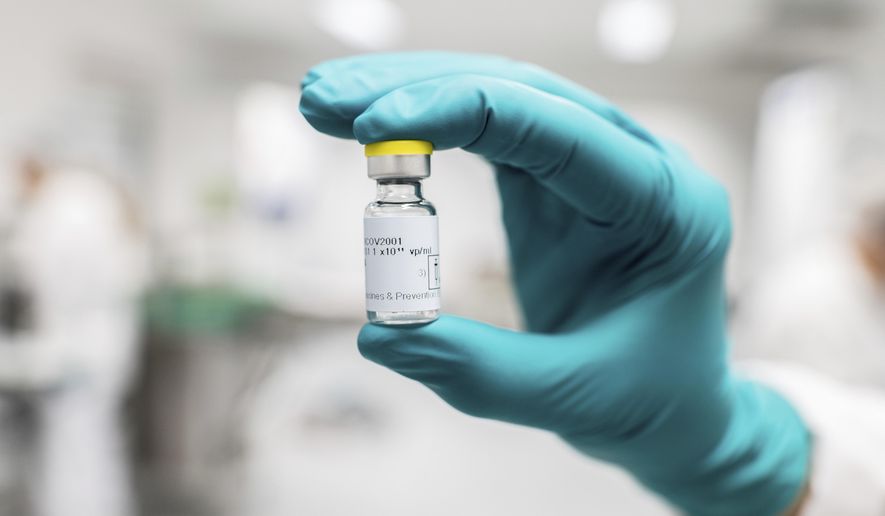A key panel on Friday endorsed the one-shot Johnson & Johnson vaccine for use in the COVID-19 fight, clearing the way for the Food and Drug Administration to grant emergency approval within a day or two.
The FDA’s advisory committee agreed, 22 votes to 0, that the benefits of the vaccine outweigh its risks for use in people 18 and older.
The J&J vaccine uses an adenovirus vector and will be the third vaccine in the U.S. arsenal.
It was developed by Janssen — the pharmaceutical company owned by J&J, a multinational corporation — and the previous COVID-19 vaccines were approved by federal regulators within a day of the panel’s vote.
President Biden hailed the news at a mass-vaccination center in Houston shortly after the vote, though he made it sound like the FDA gave the actual green light.
“They’ve approved it today,” Mr. Biden said in the parking lot of NRG Stadium, home of the Houston Texans football team.
The site can deliver up to 6,000 shots per day of the messenger-RNA vaccines from Pfizer-BioNTech and Moderna, which have been in use since December.
The site opened Tuesday and is supported by 222 active-duty personnel from the Defense Department, 13 staff members from the Federal Emergency Management Agency and 100 staffers from Harris County, Texas.
“We finally got access to the vaccine and found we didn’t have enough vaccinators — people to [get] shots in people’s arms. The first place I went, I went to FEMA, and I went to the Defense Department. This is it, man. They’re the best,” Mr. Biden told uniformed personnel during a tour of the site.
Mr. Biden said the operation has “done thousands of people” since its launch.
“In and out in a short amount of time,” Mr. Biden said.
The vaccines in circulation now require two doses to achieve the protection demonstrated in their clinical trials.
J&J’s one-dose version doesn’t require a return visit and it can last up to three months in a normal refrigerator, making it versatile. Its efficacy rate of 66% against all disease wasn’t as robust as the 95% demonstrated by the mRNA vaccines but the J&J shot did the job in staving off severe cases and hospitalization.
It was also tested in more difficult circumstances than the mRNA versions, competing with aggressive coronavirus variants circulating in Brazil and South Africa.
The first nationwide shipment of J&J vaccines will contain up to 4 million doses. Governors and localities will have to sort through how they distribute the vaccine, versus their supply of existing versions.
The federal Advisory Committee on Immunization Practices will hold an emergency meeting on the J&J vaccine on Sunday, so their recommendations should guide states and health providers.
Sarah Christopherson, a policy advocacy director at the National Women’s Health Network, said the J&J vaccine will improve access and save lives but people might need help in understanding its strengths versus vaccines that were tested and approved weeks ago.
“There is a significant concern that headline numbers are already leading to a sense among the public there are first- and second-class vaccines, with the latter relegated to low-income, rural or otherwise marginalized communities. That has the potential to exacerbate public mistrust. Public health authorities must address these perceptions head-on,” she told the FDA’s Vaccines and Related Biological Products Advisory Committee, or VRBPAC.
Vaccinators have delivered over 68 million shots of the Pfizer and Moderna vaccines to Americans.
Some of those were second doses, so the campaign has reached just shy of 50 million individuals overall, according to the Centers for Disease Control and Prevention.
The U.S. and other countries are racing to wrangle the virus so economies can return to full speed and people can resume normal life. They’re also trying to outpace dangerous mutations in the virus that can diminish the power of existing vaccines.
CDC Director Rochelle Walensky on Friday said she’s worried about a recent shift in the pandemic. U.S. case counts have started to plateau after several weeks of sharp declines, while estimates show the fast-moving “U.K.” variant of the virus accounts for 10% of reported U.S. infections.
The rolling average of daily coronavirus cases had been dropping steadily since the first week of January — from about 250,000 to around 66,000 at the start of this week, though the average has risen to about 69,000 by Thursday.
“Things are tenuous. Now is not the time to relax restrictions,” Dr. Walensky said. “Cases, hospital admissions and deaths all remain very high and the recent shift in the pandemic must be taken very seriously.”
“We may be done with the virus,” she said, “but clearly the virus is not done with us.”
• Tom Howell Jr. can be reached at thowell@washingtontimes.com.




Please read our comment policy before commenting.